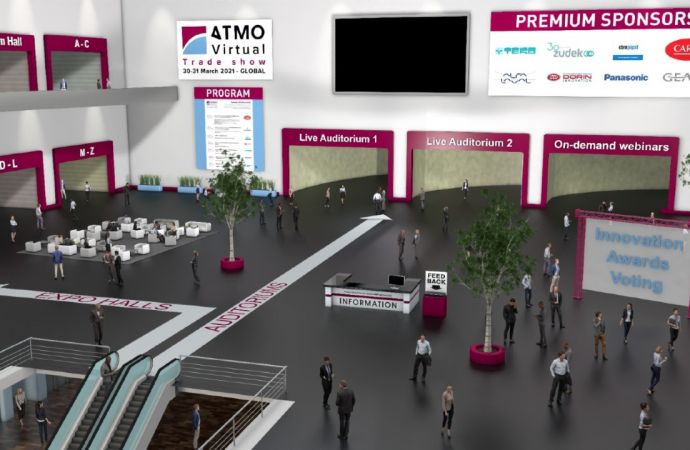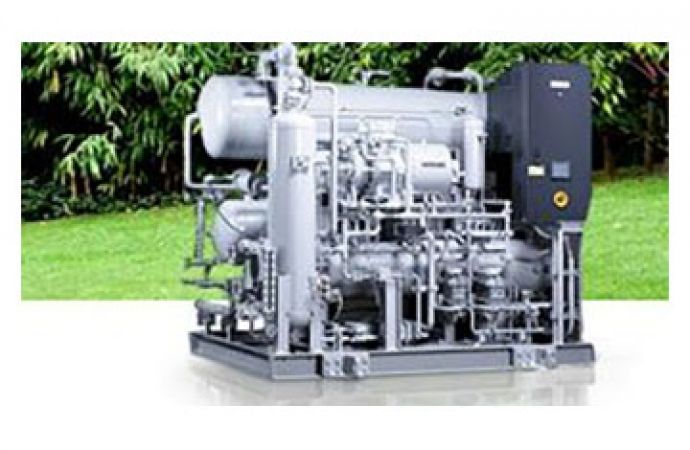ATMOsphere Asia 2014 held on 3-5 February in Tokyo, Japan, provided a platform for industry leaders to showcase some of the newest NH3/CO2 industrial refrigeration technologies being used globally. Mayekawa, Danfoss and KAV Consulting presented about their latest ammonia/CO2 industrial refrigeration installations in Japan, China and Australia.

Mayekawa’s Hideyo Asano presented the NewTon NH3/CO2 industrial refrigeration system, with ammonia as the primary refrigerant and CO2 as the secondary refrigerant. Given that most of the cold store cooling systems in Japan are two decades old and need to be replaced, the NewTon provides end-users with an environmentally friendly and energy efficient solution.
Reduced ammonia charge
The NewTon concept was developed in order to reduce the ammonia charge and provide an easy-to-maintain system with safety advantages for the end-user. CO2, selected after various other liquids were assessed, was evaluated the best secondary refrigerant in this solution.
The NewTon consists of an NH3 semi-hermetic compressor with a high-efficiency IPM (Internal Permanent Magnet) motor, proven to be more efficient by 5-10% than an induction motor. A new rotor profile was integrated into the system, in addition to a new plate heat exchanger. The package also includes a liquid CO2 tank and pump. The NewTon is suitable for 20,000 m3 to 200,000 m3 facilities.
Nearly 500 installations in Japan
There are almost 500 installations of the NewTon located around Japan, a figure that has taken 5 years to reach. One of the largest cold stores in Japan, located in Kawasaki City, features 11 NewTon packages, for -25°C frozen food and loading rooms. Compared to NH3/brine and HCFC-22 systems the NewTon NH3/CO2 system consumes on average less, and the Kawasaki cold store is the most efficient in Japan.
In March 2014, the first NewTon installation will be completed in Indonesia in a cold store operated by P.T. ADIB Global Food Supplies.
NH3 remains primary choice, with increased focus on NH3/CO2 systems for medium and large sized refrigeration plants
On behalf of Danfoss, Youichi Saito from Saginomiya presented an overview of the Danfoss case studies featuring NH3/CO2 systems and their components developed for natural refrigerants. According to the presentation, ammonia still ranks number one as the refrigerant of choice in medium and large sized industrial refrigeration plants; however, there is an increased focus on NH3/CO2 secondary and cascade systems in Japan, North America and Europe. In Japan CO2 is starting to make significant inroads as a secondary refrigerant in industrial refrigeration systems in cold storage and food processing facilities.
China a 44,300m2 cold store project using NH3/CO2 technology
Weihai Jiuye Cold Storage Co. Ltd. in China opted to install an NH3/CO2 system because of the system’s high efficiency. The NH3 charge is reduced to 1/10th that of traditional systems, a key point that addresses safety concerns and allows for the construction of large plants in heavily populated areas. The project has the following features:
Compared to the original system, which had an efficiency of 118 kWh/tonne, the NH3/CO2 system achieves an energy saving of 11%.
NH3 fruit storage and sterilisation facility
Involved in over 800 NH3 projects over the past 45 years Klass Visser of KAV Consulting, based in Australia, opened his presentation by referring to his first visit to Japan in the 1950s when he came to Yokohama on a ship that was refrigerated with CO2, he noted, “there is really nothing new under the sun!” commenting on the long-time adoption of natural refrigerants.
Visser was asked to provide a solution to double the cooling capacity of a refrigerated fruit warehouse, used to store and cold sterilise products at 1°C to prevent fruit flies. The required refrigeration capacity increase was 110-190 kW depending on the fruit’s temperature. The maximum power supply capacity increase allowed was 9.5%.
The solution Visser developed was to replace the original R22 system with an ammonia-glycol refrigeration system, doubling the cooling capacity whilst not increasing the energy consumption.
The projected increase in connected load amounted to 66 – 81 KW, i.e. 22-27%, and the system was initially built with some of the following features:
Overall the ammonia-glycol system only increased the maximum demand (MD) by 16.4 kW or 4.2%, which was achieved with a refrigeration capacity increase of 60%.
Visser concluded his presentation with a series of recommendations for future research to improve ammonia refrigeration systems:
Reduced ammonia charge
The NewTon concept was developed in order to reduce the ammonia charge and provide an easy-to-maintain system with safety advantages for the end-user. CO2, selected after various other liquids were assessed, was evaluated the best secondary refrigerant in this solution.
The NewTon consists of an NH3 semi-hermetic compressor with a high-efficiency IPM (Internal Permanent Magnet) motor, proven to be more efficient by 5-10% than an induction motor. A new rotor profile was integrated into the system, in addition to a new plate heat exchanger. The package also includes a liquid CO2 tank and pump. The NewTon is suitable for 20,000 m3 to 200,000 m3 facilities.
Nearly 500 installations in Japan
There are almost 500 installations of the NewTon located around Japan, a figure that has taken 5 years to reach. One of the largest cold stores in Japan, located in Kawasaki City, features 11 NewTon packages, for -25°C frozen food and loading rooms. Compared to NH3/brine and HCFC-22 systems the NewTon NH3/CO2 system consumes on average less, and the Kawasaki cold store is the most efficient in Japan.
In March 2014, the first NewTon installation will be completed in Indonesia in a cold store operated by P.T. ADIB Global Food Supplies.
NH3 remains primary choice, with increased focus on NH3/CO2 systems for medium and large sized refrigeration plants
On behalf of Danfoss, Youichi Saito from Saginomiya presented an overview of the Danfoss case studies featuring NH3/CO2 systems and their components developed for natural refrigerants. According to the presentation, ammonia still ranks number one as the refrigerant of choice in medium and large sized industrial refrigeration plants; however, there is an increased focus on NH3/CO2 secondary and cascade systems in Japan, North America and Europe. In Japan CO2 is starting to make significant inroads as a secondary refrigerant in industrial refrigeration systems in cold storage and food processing facilities.
China a 44,300m2 cold store project using NH3/CO2 technology
Weihai Jiuye Cold Storage Co. Ltd. in China opted to install an NH3/CO2 system because of the system’s high efficiency. The NH3 charge is reduced to 1/10th that of traditional systems, a key point that addresses safety concerns and allows for the construction of large plants in heavily populated areas. The project has the following features:
- Temperature in: 10°C
- Temperature out: -18°C
- Duration: 30mins
- Efficiency: 105 kWh/Ton
Compared to the original system, which had an efficiency of 118 kWh/tonne, the NH3/CO2 system achieves an energy saving of 11%.
NH3 fruit storage and sterilisation facility
Involved in over 800 NH3 projects over the past 45 years Klass Visser of KAV Consulting, based in Australia, opened his presentation by referring to his first visit to Japan in the 1950s when he came to Yokohama on a ship that was refrigerated with CO2, he noted, “there is really nothing new under the sun!” commenting on the long-time adoption of natural refrigerants.
Visser was asked to provide a solution to double the cooling capacity of a refrigerated fruit warehouse, used to store and cold sterilise products at 1°C to prevent fruit flies. The required refrigeration capacity increase was 110-190 kW depending on the fruit’s temperature. The maximum power supply capacity increase allowed was 9.5%.
The solution Visser developed was to replace the original R22 system with an ammonia-glycol refrigeration system, doubling the cooling capacity whilst not increasing the energy consumption.
The projected increase in connected load amounted to 66 – 81 KW, i.e. 22-27%, and the system was initially built with some of the following features:
- Propylene glycol circulating pump
- High-efficiency PGC pump to reduce electrical energy consumption
- Minimum 2 ammonia compressors
- VSDs fitted to all compressors
- New evaporative condenser fan & pump
- ECM motors specified to drive fans on the new glycol coolers
Overall the ammonia-glycol system only increased the maximum demand (MD) by 16.4 kW or 4.2%, which was achieved with a refrigeration capacity increase of 60%.
Visser concluded his presentation with a series of recommendations for future research to improve ammonia refrigeration systems:
- Formulation of an oil miscible with NH3. (Automatic mechanical oil return to the compressor is feasible but expensive.)
- Improved oil separators
- Small two stage NH3 compressors to get around high-discharge temperatures
- Efficient heat exchangers for both the condensing and evaporating functions
MORE INFORMATION
Related stories






